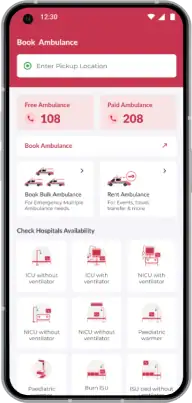India, with its vast and diverse landscape, faces significant challenges in providing accessible healthcare, especially in remote areas. Coastal and riverine regions pose additional hurdles due to their geographical constraints. In such areas, emergencies often require immediate medical attention that is inaccessible due to lack of infrastructure. This is where the concept of a boat ambulance comes into play, offering a unique solution to address healthcare gaps. In this blog, we will delve into the pressing need for water ambulances in India and explore how they can revolutionize healthcare access.
Healthcare Challenges in Coastal and Riverine Regions of India
Remote coastal and riverine areas in India suffer from inadequate healthcare infrastructure, leaving communities vulnerable during emergencies. The absence of well-equipped medical facilities, qualified personnel and efficient transportation exacerbates the situation. In critical situations, every minute counts and the inability to provide timely medical interventions can have severe consequences.
Understanding Boat Ambulances
Boat ambulances, also known as floating healthcare units, are specialized vehicles designed to provide emergency medical services in water-bound regions. These ambulances are equipped with necessary medical equipment, including oxygen supplies, defibrillators and first aid kits. Additionally, they are staffed by trained medical professionals who can administer initial care during emergencies. Water ambulances are specifically tailored to navigate through water bodies, enabling them to reach remote areas swiftly.
Need for Boat Ambulances in India
Boat ambulances can play a crucial role in transforming healthcare access in India's coastal and riverine regions. These specialized healthcare units can address the unique challenges posed by remote water-bound areas, where traditional land-based ambulances face limitations. The role of water ambulances extends beyond providing emergency medical services; they serve as lifelines for communities in need. Firstly, water ambulances can significantly reduce response times in emergencies, ensuring timely medical interventions that can save lives. By navigating through water bodies, they can reach isolated communities that would otherwise be inaccessible. This is particularly critical in situations such as accidents, natural disasters or medical emergencies where every moment counts. Moreover, boat ambulances can provide immediate medical care on board, stabilizing patients and minimizing the risk of complications during transportation. Equipped with essential medical equipment and staffed by trained professionals, these ambulances can deliver initial treatment, administer life-saving medications and offer vital support until the patient reaches a proper medical facility. Additionally, boat ambulances can improve healthcare outreach by facilitating medical camps and awareness programs in remote areas. They can serve as mobile clinics, delivering preventive care, conducting health screenings and offering healthcare education to underserved communities.
Potential Challenges and Solutions in Implementing Boat Ambulances in India
Implementing boat ambulances in India presents several challenges that need to be addressed for successful deployment. Firstly, establishing the necessary infrastructure, including docking stations and maintenance facilities, can be logistically complex, especially in remote areas. Adequate investment and coordination between government bodies, healthcare organizations and local communities are essential to overcome this challenge. Secondly, ensuring a trained and qualified medical staff for water ambulance services is crucial. Specialized training programs should be developed to equip healthcare professionals with the skills needed to handle emergencies on water bodies. Collaboration with medical institutions and organizations can help create standardized training protocols for boat ambulance crews. Furthermore, funding and sustainability of water ambulance initiatives require careful consideration. Government support, public-private partnerships and philanthropic contributions can help secure the necessary financial resources. Long-term sustainability plans, such as revenue generation models or cost-sharing mechanisms, should be explored to ensure the continued operation of boat ambulance services.
Support and Initiatives for Boat Ambulances in India
Recognizing the significance of boat ambulances, the Indian government has taken steps to support and promote their implementation. Various policies and initiatives have been introduced to encourage the establishment of boat ambulance services in coastal and riverine regions. Non-profit organizations and the private sector have also played a vital role in supporting these initiatives. Collaborations and partnerships between different stakeholders can further drive the momentum of water ambulance implementation.
Conclusion
The pressing need for water ambulances in India cannot be underestimated. These specialized healthcare units have the potential to revolutionize healthcare access in remote coastal and riverine regions, where traditional land-based ambulances face significant challenges. By swiftly reaching areas inaccessible by road, boat ambulances can provide timely medical interventions and save lives during emergencies. One of the reliable boat ambulance providers in India is MedCab. MedCab has been at the forefront of implementing boat ambulance services, leveraging its expertise and experience to bridge healthcare gaps. With our well-equipped floating healthcare units and trained medical professionals, MedCab has demonstrated the effectiveness of water ambulances in delivering emergency medical services in water-bound areas.






